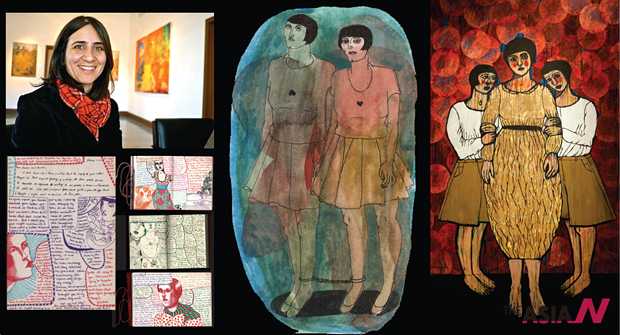Kuwaiti painter seeks to expose social contradictions

Artist Ghada Alkandari of Kuwait and her diaries written in small booklets and brilliantly enter into the world of the graphic novel in which she is a pioneer. She presents women’s community more truthfully and perfectly.
*Editor’s note: This is the second installment of six-part stories about six Arab women artists devoting themselves to creating different style of art and innovating their methods of expression for “revolutionary” change.
Ghada Alkandari “A Pretty Green Bullet”
“My name is Ghada Alkandari, an artist and ambitious blogger from Kuwait. I only realized that when I started my blog in April 2010, and I was also sure that I’m a diarist and painter. To me the blog is my real, special world and my space in which I share my ideas and feelings with anybody who wants to listen to me, in a country where intellectuals and artists (men and women) are divided. I like the idea of having a group of people somewhere who have access to my world. Professionally, I have exhibited my works locally and abroad, and I insist on being a writer and drawer of children’s books. I’ve drawn some of such books for other organizations and writers, nonetheless, there is a book I started years ago and wish to complete, which I may do some day,” she wrote.
I have always been eager to listen to artists’ voices, diaries and memoirs. Leading artists’ biographies are informative and revealing. It happened by chance one evening at Kuwait airport as I was waiting for departure that, as usual, I had my favourite cup of coffee in a shop where I read Bazaar magazine, which is produced by young Arab and other writers in Arabic and English reflecting their energetic youth and niche markets. I was really pleased to live enjoyable moments with a dialogue in English, whose writer, artist Ghada Alkandari, filled with questions and comments by visitors to her blog which she started over a year ago. She sometimes asks and answers questions herself. It is the spirit of a revolutionary artist who does not talk much but is good at blogging. In her first lines I introduced myself as she liked.
Though I saw many exhibitions of her works, I prefer to navigate through cyberspace which I regard as the objective correlative of the hidden revolutions in the works of Arab women artists, which she calls “a beautiful green bullet”, containing all those many contradictions in our Arab societies and the world which she chose to present to her audience.
Between her birth in India and graduation from the American University in Cairo she lived a life of travel around the world with her father, a Kuwaiti ambassador. When she organized her first exhibitions in Kuwait her new sense of art was favourably received by art lovers.
Her works have a number of features: First, fine, embroidered details of the world of women, extremely special intimacy, including worldly pleasures, feminine quarrels, daily routine, colourful language, a heavy, leisured body leaning firmly on the painting in addition to the family world: children, rituals, etc. That’s how she presented women’s community more truthfully and perfectly.
Second, her academic distinction, not only in terms of her ability to dissect the human body from a new angle in which women are reduced to powerful lines and, with many gleaming details, clothes turn into captivating motifs and show women’s faces like novel vanity cases. As a young woman she remembers popular Kuwaiti games, which she might have watched films or heard about from mothers and grandmothers. She introduces this world in a new, interesting language which moves vigorously like a train crossing the desert, bringing joy; a surge in introducing Kuwait’s popular world.
Third, a close rapport with her audience. We see this in her “private” messages which are not so any more, now that her visitors are able to read them. The little Kuwaiti girl who, according to her mother, used to draw in a neglected corner of the house, is the same Kuwaiti artist who, with her spontaneous childlike feelings, writes in an electronic corner, but allows us to hear and see. The artist is keen on expression and change, which is only achieved through sharing a wider community. That’s why her works vary in size : large works in exhibitions; interesting, bold diaries in small booklets brilliantly entered into the world of the graphic novel. I think she will be the first Arab artist to introduce this art successfully if she puts it among her many projects which she has been planning for as long as a whole decade.
Finally, her deep interest in children and as a mother she is more aware of the need to develop children’s visual taste. As she said, she had drawn pictures for stories published by the Kuwait Society for the Progress of Arab Children, including My Grandmother Dalal and Games, Man-Made Afreets and At The Toy shop, but she wants to take on her own world with words and pictures, letters and colours.
Artist Ghada Alkandari is leading a silent, but influential, revolution and she will convey her message because it is a Pretty Green Bullet, as her blog is entitled.










































































